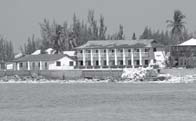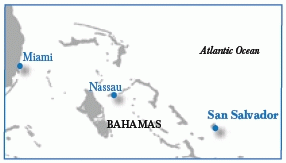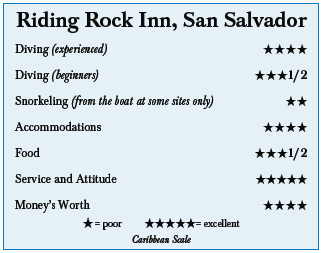Riding Rock Inn, San Salvador, BahamasContents of this Issue: Riding Rock Inn, San Salvador, Bahamas Get Published in the 2010 Chapbook! Extra Costs on Your Next Dive Trip: Part II Have Problems With Your Maskís Upward Vision? Creating One Big Happy Group Dive Trip A Reminder About Safe Boat Diving from PADI Perfect Your Underwater Photos Hurricane Omar Damages Bonaireís Reefs But Saves Its Eels Editorial Office: Ben Davison Publisher and Editor Undercurrent 3020 Bridgeway, Suite 102 Sausalito, CA 94965 wall diving close to the U.S., but still far from crowds from the April, 2009 issue of Undercurrent
Dear Fellow Diver: With money tight for exotic dive trips, itís good to know interesting wall diving and numerous shark sightings can be had just 360 miles southeast of Miami. Morning dives were the best part of my trip to San Salvador. On one morning dive, after a 35-minute boat trip to North Pole Cave at the islandís southern end, I passed a school of blue-striped and white grunts at the top of the reef, with chubs, schoolmasters and horse-eye jacks in the mix. Making like Santa Claus (the site name refers to his Christmas Eve descents), I entered a chimney at 60 feet, headed down to 110 feet, then into a crevice that exits into the blue at 135 feet. Curly wire corals grace the wall around the exit, along with big barrel sponges, one with three big spouts. One crack further on was loaded with a dozen black jacks. Yes, San Salís walls put it among the better dive destinations in the Caribbean/ Atlantic, offering up sharks on most dives.
The Bahamasair connector flight from Nassau to tiny San
Salvador is a short hop but a world apart. I stepped off
the plane into one of those delightful little airports where
the luggage comes to you on a four-wheeled cart and shopping
options are limited to rum or beer. Riding Rockís van driver
surprised me by saying that my partner and I comprised the
entire Saturday group of divers. Maybe itís the winter off
season -- water is
considerably cooler
then -- or the economy
that kept people
away. Even for just two divers, Riding Rockís dive operation didnít give short shrift. No need to haul tanks to the 42-foot dive boat; they had been loaded and filled, always to 3,000 plus. Divemaster Lynn, a competent Brit with experience in the Pacific and Caribbean, prepped two divers for their last two openwater course dives. Captain Bruce, a Nassau native who has steered this boat for years, took us to the morning dive at Shangri-La, where he hooked to a buoyed mooring line, the routine for all dives. The general pattern for dives was down the wall one way, then back along the top of the reef, usually at 40-50 feet, toward the boat. Current was nil all week. I was underwhelmed by Shangri-La -- not the big wall scene and swim-throughs I expected. Still, three reef sharks cruised a short distance off in the blue. They appeared on every dive, usually six-footers in a mellow mood, sometimes shadowed by a bar jack. After plumbing the depths of North Pole Cave, I found what looked like a killing field of staghorn coral rubble back up top, with scattered live colonies. The coral did look very healthy at some sites but there were dead and algae-covered patches, too. A scientist at the reef research station there told me they have tracked significant loss of live coral since he started 17 years ago. Itís not only from global warming, the increased desertification of the Sahara is stressing and killing corals in the Caribbean and Western Atlantic via a fungus that travels from Africa on dust particles in the trade winds. The dive rules up front: computer required, 45 minutes maximum dive time, and a maximum depth of 100 feet unless the dive is planned deeper. The 8:30 a.m. dives were a 35-minute ride to San Salís south end and its deep cracks, tunnels and sand chutes. The 2:30 p.m. dives were usually within 10 minutes of the marina. Because it was just us two on dives, I had plenty of time to explore the coral and cracks with my light and magnifying glass. The two V-hulled boats with twin diesel engines have bench seating along a rack for about 24 tanks on each side, sun cover, a head, and a DAN O2 kit. Each holds 20 divers. Lynn said a big group would get two divemasters, with entries spaced by five minutes. Drinking water and orange wedges were handed out during the hour-long morning interval on board. Captain Bruce and Lynn helped with gear and hosed off my BCD and regulator each afternoon, while I rinsed and hung my wetsuit at their dive shop. Riding Rock is managed by San Sal native Michelle Williams, whose family has owned
it for 20 years. Weather is definitely a concern in February because San Sal is north of the Caribbean. While daytime temperatures were comfortable, water averaged 75 degrees; I used a 3-mm suit but I got chilled at the end of dives. While an occasional cold front can bring wind, swells, murky visibility and cool temperatures on the boat, I had sun every day and wind just one afternoon. I wouldnít go there again in winter, because weather could spoil much of the week. When weather blew out the Tuesday night dive, management didnít offer to reschedule. I didnít press the point because I preferred sunny afternoon dives to cool evening ones but I had some regrets when Lynn said reef sharks are in hunting mode after dark, and lionfish use diversí lights to hunt. Speaking of lionfish, that Indo- Pacific species is now common here (go online to the Undercurrentís September 2007 issue for details about how they got to the Atlantic and Caribbean). We saw up to six on most dives, usually in pairs nestled in the wall. Riding Rock divemasters once speared lionfish to reduce numbers locally, but no longer. As dive shop manager, Lynn told me she wonít allow it until research demonstrates itís the right approach to eliminating them. Captain Bruce said he eats them regularly and finds them quite tasty. Skip the grouper, pass the lionfish? One afternoon I walked to Cockburn Town to pass time. Itís one of the two main settlements on San Sal, with a population of 1,200. I visited the few stores and bars, pausing to read the small-town announcements about upcoming Valentineís Day parties posted on storefronts. A rusty 10-foot iguana statue guards the town and the long, deserted beach to the south. Colorful bananaquits and palm warblers made more noise than the sparse car traffic. My kind of place. In the innís Driftwood Lounge, Peaches, the longtime bartender, suggested rum drinks with a dozen ingredients but I stuck with Kalik, a decent Bahamian beer at $4. We ate in the 40-seat dining room, where a few fishermen and boaters sometimes joined us. Michelle told me rooms are already booked solid for most of June and July, when water temps reach the 80s. Then the place definitely would have a different feel, with 30 divers on the two boats and packing the funky Driftwood, which Lonely Planet calls the happening place on San Sal. I usually shared the bar with a few folks off a sailboat stopping at the RR marina or fishermen, who reported landing big wahoo daily. Meals were above par for such an isolated venue. American-style breakfasts are to order. No menu, just order what you want in your omelet or what meat with your pancakes, with OJ and a choice of fresh fruit on the side. Lunch started with an excellent conch chowder, then a couple of choices like a sandwich or baked chicken. Dinners began with a simple salad and a glass of wine, followed by a couple of entrťe choices. Half the time, I had fresh fish, usually wahoo or mahi. Other entrťes included steak, Cornish hen, and lamb chops. Dessert was homemade cake or pie. Lynn was determined that I see great hammerheads, so we spent the latter half of my trip on the back reef where the big guys are common, but I would have been happy there anyway. Most sites had huge fields of garden eels, with rosy razorfish and the occasional green razorfish diving under the sand, yellowhead jawfish hovering above, bridled blennies, and tilefish near their rubble piles almost as big as beaver lodges. Southern stingrays all seemed to have a darkened bar jack hunting partner, and they were outnumbered here by smaller yellow stingrays. Halfway into the dive at Stew Pot, Lynn put two fists on her temples, and there it was -- a 10-foot hammerhead halfway up the water column. On the next dive at Three Barrels, I saw another, this time in better display as it glided over the reef top into the blue. On my sixth and final dive day, I got to choose two sites to revisit. At Double Caves, one tunnel entrance was nearly barred by a big blue parrotfish. I entered another and emerged on the wall at 115 feet just as a reef shark passed. As I worked my way up, four eagle rays glided by in close formation. Soon after, two 10-foot hammers came into view just off the reef. I watched them disappear, then a minute later one of them returned for a second look at me. As I neared the lip of the reef, Creole wrasse poured over the top and parted around me, along with a school of yellow goatfish nearby. Great barracuda donít often aggregate, but 30 of them gathered over the sand here, as well as on several other dives. Clearly a good fishy Atlantic/Caribbean dive. Riding Rock offers an all-inclusive package, but theyíre somewhat pricey. You could book a similar all-inclusive dive week at CoCoView for $500 less but, depending where you live, you would probably pay more to fly to Honduras, and not get the variety of dive sites, nor the chance to swim with sharks. If you donít have the time or the airfare to travel double-digit hours for diving, fly to Nassau between May and July (or later if you recognize the hurricane risk), then take the daily puddle-jumper to San Sal. Thatís all it takes to get you finning along the walls and near the sharks. -- M.A.
|

I want to get all the stories! Tell me how I can become an Undercurrent Online Member and get online access to all the articles of Undercurrent as well as thousands of first hand reports on dive operations world-wide
| Home | Online Members Area | My Account |
Login
|
Join
|
| Travel Index |
Dive Resort & Liveaboard Reviews
|
Featured Reports
|
Recent
Issues
|
Back Issues
|
|
Dive Gear
Index
|
Health/Safety Index
|
Environment & Misc.
Index
|
Seasonal Planner
|
Blogs
|
Free Articles
|
Book Picks
|
News
|
|
Special Offers
|
RSS
|
FAQ
|
About Us
|
Contact Us
|
Links
|
3020 Bridgeway, Ste 102, Sausalito, Ca 94965
All rights reserved.


 The group on my
planned dive-shop trip
dissolved when the
recession hit some of
the divers hard, so
my partner and I were
the only ones that
remained from that
bunch. On the upside,
we pretty much had the dive boat, the sharks, and sometimes the whole
resort to ourselves.
The group on my
planned dive-shop trip
dissolved when the
recession hit some of
the divers hard, so
my partner and I were
the only ones that
remained from that
bunch. On the upside,
we pretty much had the dive boat, the sharks, and sometimes the whole
resort to ourselves. The place is nothing fancy, 42 rooms in motel-like buildings bordered
by the beach, pool and open-air
bar. My deluxe room on the second floor
was comfortable and spotless, with two
queen beds, mini-fridge and cable TV.
On the small balcony overlooking the
ocean, I sat to read and watch kestrels
flying between trees. The inn has the
friendly feel of a family-run operation
but the schedule is run on a strict
Saturday-to-Saturday regimen. Conch
fritters are served in the bar Saturday
and Monday, night dives are Tuesday, BBQ
is WednesdayÖyou get the idea. Tuesday
afternoons are for an interesting twohour
tour around the island where
Columbus probably landed in 1492. During
high season, groups tour by bus but during
this slow period, Michelle took us
in her own car.
The place is nothing fancy, 42 rooms in motel-like buildings bordered
by the beach, pool and open-air
bar. My deluxe room on the second floor
was comfortable and spotless, with two
queen beds, mini-fridge and cable TV.
On the small balcony overlooking the
ocean, I sat to read and watch kestrels
flying between trees. The inn has the
friendly feel of a family-run operation
but the schedule is run on a strict
Saturday-to-Saturday regimen. Conch
fritters are served in the bar Saturday
and Monday, night dives are Tuesday, BBQ
is WednesdayÖyou get the idea. Tuesday
afternoons are for an interesting twohour
tour around the island where
Columbus probably landed in 1492. During
high season, groups tour by bus but during
this slow period, Michelle took us
in her own car.  Diverís Compass: I paid $1,663 per person for an all-inclusive, double-
occupancy package in a deluxe room, with 17 dives over seven days
. . . taxes and restaurant tips were included, liquor and boat tips
were extra . . I recommend the upstairs ocean-side rooms . . . The
only other charge I incurred was $20 for a golf cart (ďkeep to the
leftĒ) on my last afternoon to go birding at the ruins of Watling
Castle and walk miles of beautiful, deserted beaches . . . Bahamasair
(
Diverís Compass: I paid $1,663 per person for an all-inclusive, double-
occupancy package in a deluxe room, with 17 dives over seven days
. . . taxes and restaurant tips were included, liquor and boat tips
were extra . . I recommend the upstairs ocean-side rooms . . . The
only other charge I incurred was $20 for a golf cart (ďkeep to the
leftĒ) on my last afternoon to go birding at the ruins of Watling
Castle and walk miles of beautiful, deserted beaches . . . Bahamasair
(